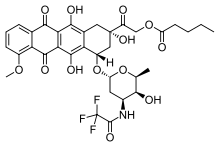Valrubicin
Valrubicin (N-trifluoroacetyladriamycin-14-valerate, trade name Valstar) is a chemotherapy drug used to treat bladder cancer. Valrubicin is a semisynthetic analog of the anthracycline doxorubicin, and is administered by infusion directly into the bladder.
 | |
| Clinical data | |
|---|---|
| AHFS/Drugs.com | Consumer Drug Information |
| MedlinePlus | a611021 |
| Pregnancy category |
|
| Routes of administration | Intravesical |
| ATC code | |
| Legal status | |
| Legal status |
|
| Pharmacokinetic data | |
| Bioavailability | Negligible |
| Protein binding | >99% |
| Metabolism | Negligible |
| Excretion | In urine |
| Identifiers | |
| |
| CAS Number | |
| PubChem CID | |
| DrugBank | |
| ChemSpider | |
| UNII | |
| ChEMBL | |
| CompTox Dashboard (EPA) | |
| ECHA InfoCard | 100.205.793 |
| Chemical and physical data | |
| Formula | C34H36F3NO13 |
| Molar mass | 723.651 g·mol−1 |
| 3D model (JSmol) | |
| |
| |
| (verify) | |
It was originally launched as Valstar in the U.S. in 1999 for intravesical therapy of Bacille Calmette-Guérin (BCG)-refractory carcinoma in situ of the urinary bladder in patients in whom cystectomy would be associated with unacceptable morbidity or mortality; however, it was voluntarily withdrawn in 2002 due to manufacturing issues.[1] Valstar was relaunched on September 3, 2009.[2]
Side effects
- Blood in urine
- Incontinence
- painful or difficult urination
- Unusually frequent urination
References
- "Manufacturing Issues Remain for Indevus' Valstar", U.S. Food and Drug Administration News. The MQN Weekly Bulletin, Jan. 11, 2008
- "Endo Pharmaceuticals launches VALSTAR for treating recurrent carcinoma in situ bladder tumors" (Press release). 2009-09-03. Retrieved 2009-11-26.
This article is issued from Wikipedia. The text is licensed under Creative Commons - Attribution - Sharealike. Additional terms may apply for the media files.